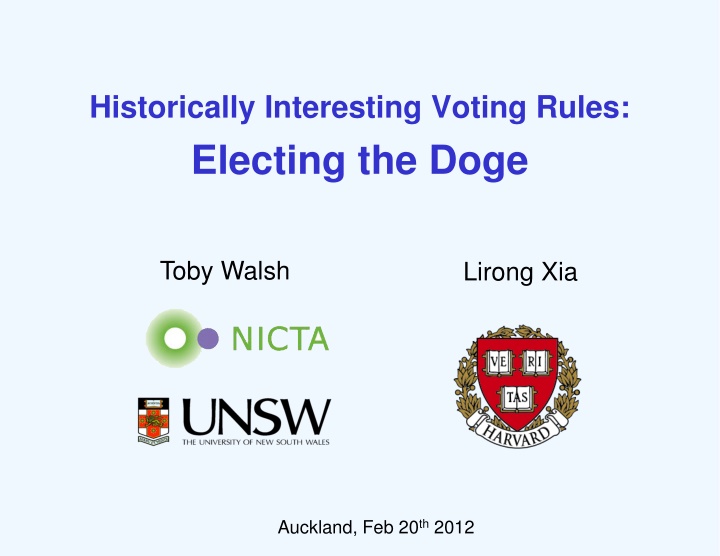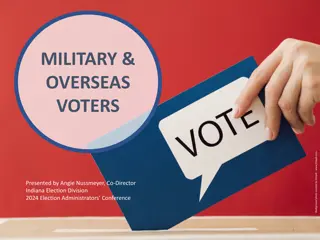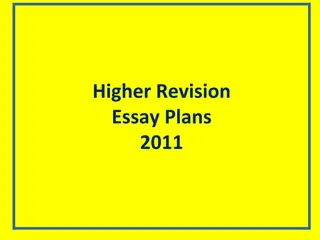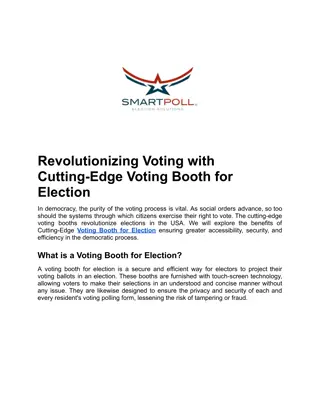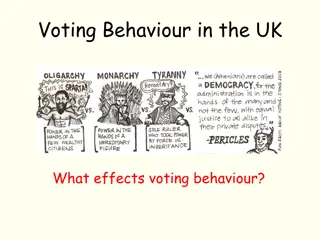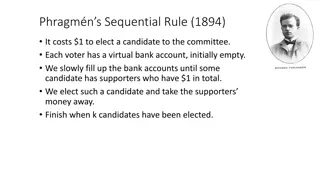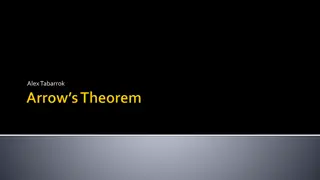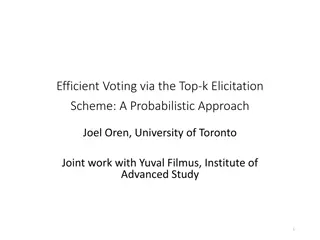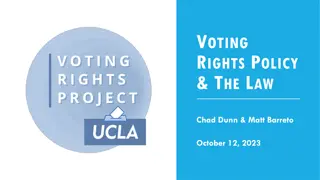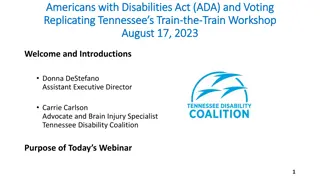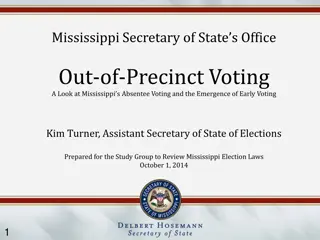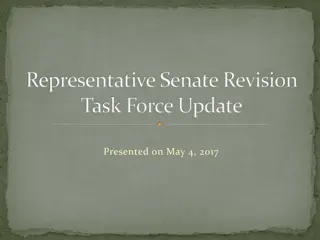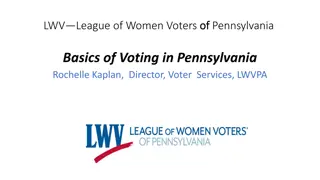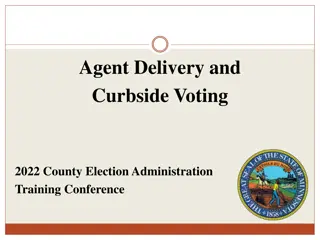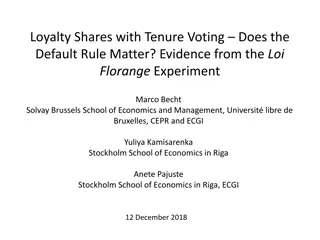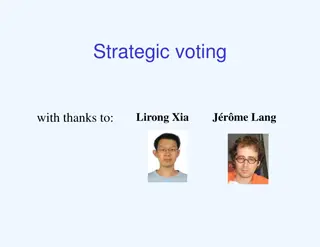Electing the Doge: Historical Voting Methods & Implications
Study of a randomized pre-round to eliminate voters in electing the Doge of Venice, a complex electoral system between 1268 and 1797 aimed at minimizing corruption. The system involved multiple rounds combining lottery, approval-like voting, and plurality approaches, with the final 41 members of the Maggior Consiglio electing the Doge. Historical context and sophistication of the process are discussed.
Download Presentation

Please find below an Image/Link to download the presentation.
The content on the website is provided AS IS for your information and personal use only. It may not be sold, licensed, or shared on other websites without obtaining consent from the author.If you encounter any issues during the download, it is possible that the publisher has removed the file from their server.
You are allowed to download the files provided on this website for personal or commercial use, subject to the condition that they are used lawfully. All files are the property of their respective owners.
The content on the website is provided AS IS for your information and personal use only. It may not be sold, licensed, or shared on other websites without obtaining consent from the author.
E N D
Presentation Transcript
Historically Interesting Voting Rules: Electing the Doge Toby Walsh Lirong Xia Auckland, Feb 20th 2012
Executive summary We study the impact of a randomized pre-round to eliminate some voters 1
Electing the Doge Leonardo Loredan, Doge 1501-1521 2
Electing the Doge Leonardo Loredan, Doge 1501-1521 Art history aside: One of the 1st portraits of a mortal that is not in profile 3
Electing the Doge Similar voting rules used in many other Italian cities 4
Electing the Doge One of the longest running electoral systems Used between 1268 and 1797 One of the most complex electoral systems 10 rounds of voting! 5
Electing the Doge The main idea . . . seems to have been to introduce a system of election so complicated that all possibility of corruption should be eliminated [Wolfson 1899] 6
Electing the Doge actions which do not increase security, but which are designed to make the public think that the organization carrying out the actions is taking security seriously . offers some resistance to corruption of voters [Mowbray&Gollmann 07] 7
Electing the Doge 1000 lottery 30 Round 1: lottery 30 Round 2: 9 Approval like voting 40 9 Round 3: Plurality 41 Round 10: The winner must receive >24 votes 8
Electing the Doge 1000 (male and 30 years and older) members of the Maggior Consiglio Reduce by lot to 30 then 9, then elect 40 Reduce by lot to 12, then elect 25 Reduce by lot to 9, then elect 45 Reduce by lot to 11, then elect 41 These 41 elect Doge 9
Electing the Doge This still only a simplified description Only one person from each family allowed to be selected in each lottery None of the electoral colleges of size 9, 11 or 12 were allowed to be members of final 41 Enlarging electoral college used an approval like rule, each voter nominates a candidate, they need to receive a threshold of approvals 10
Electing the Doge Two interesting features Lottery to eliminate some voters Voters vote not on the Doge but on themselves and who goes through to next round 11
Electing the Doge Two interesting features Lottery to eliminate some voters (THIS TALK) Voters vote not on the Doge but on themselves and who goes through to next round (FUTURE WORK) 12
Lot based voting LotThenX Run a lottery to pick a subset of k voters Then run voting rule X Doge election used several rounds of LotThenApproval 13
Lot based voting Many other Italian cities Election of Archbishop of Novgorod One of oldest offices in Russian Orthodox Church 14
Lot based voting Many other Italian cities Election of Archbishop of Novgorod One of oldest offices in Russian Orthodox Church City-state of Athens 15
Lot based voting In use today Election of the Chair of the Internet Engineering Task Force Standards committee for TCP/IP and other internet protocols Russ Housley Random subset of 10 of the 100+ electorate chose the chair 16
Lot based voting Lottery used to select Citizen s Assembly that voted on electoral reform in BC (2004) For the curious, they decided on STV 17
Lot based voting Lottery used to select Citizen s Assembly that voted on electoral reform in BC (2004) For the curious, they decided on STV Lottery used to select Citizen s Assembly that voted on electoral reform in ON (2006) For the curious, proportional system they recommended rejected by voters of ON 18
Lot based voting Spanish savings banks To elect committee that represents account holders Proposed to reform the British House of Lords, and US House of Representatives 19
Why use lotteries? Arguments for: Representative Egalitarian Less corruptible Power to ordinary people No voter fatigue No political parties .. 20
Why use lotteries? Arguments for: Arguments against: Representative Can select unqualified people Egalitarian Can select people holding minority views Less corruptible Power to ordinary people Accountability No voter fatigue Verification of randomness No political parties .. 21
This Talk Does using a lottery provide some shield against manipulation? If it makes it (computationally) hard to predict who wins, perhaps we ll have no alternative but to vote truthfully 22
Previous work LotThenX is a randomized voting rule [Gibbard 77] proved that with 3+ candidates, a randomized voting rule that satisifes Pareto optimality is a random dictatorship LotThenX if k=1 23
Previous work LotThenX is a randomized voting rule Universal tweaks [Conitzer Sandholm 03, Elkind Lipmaa 05] added pre-round where some candidates (not voters) are eliminated [Gibbard 77] proved that with 3+ candidates, a randomized voting rule that satisifes Pareto optimality is a random dictatorship Often makes manipulations NP-hard to find LotThenX if k=1 24
Winner determination EVALUATION: can a given candidate win with a probability strictly larger than p Is the probability greater than p that we land a world in which the lottery selects voters who then elect this candidate? 26
Winner determination EVALUATION: can a given candidate win with a probability strictly larger than p NB actually computing the winner in any of these worlds is polynomial (supposing X is polynomial itself) 27
Winner determination EVALUATION: can a given candidate win with a probability strictly larger than p Theorem. EVALUATION for LotThenBorda is NP-hard Theorem. Computing the probability for a given candidate to win under LotThenBorda is #P-complete 28
Winner determination EVALUATION: can a given candidate win with a probability strictly larger than p Theorem. EVALUATION for LotThenCopeland is NP-hard Theorem. EVALUATION for LotThenMaximin is NP-hard Theorem. EVALUATION for LotThenRankedPairs is NP-hard 29
Reminder Copeland Each candidate gets 1 point every time they pairwise beat another candidate, highest scoring candidate wins Maximin Score in any pairwise election is #votes for - #votes against, candidate s overall score is smallest such score, winner is candidate with highest overall score Ranked Pairs Take each unordered pair in turn, order according to pairwise election between them unless this violates transitivity. Top of this ordering is winner. 30
Small elections? Theorem.EVALUATION for LotThenCup is NP-hard when votes are weighted and there are 3 or more candidates Theorem. EVALUATION for LotThenApproval is not in P (supposing P NP) for weighted votes and 2 or more candidates Polynomial-time Turing reduction of SUBSET- SUM to EVALUATION for LotThenApproval 31
Small elections? Theorem.EVALUATION for LotThenCup is NP-hard when votes are weighted and there are 3 or more candidates Theorem. EVALUATION for LotThenMajority is not in P (supposing P NP) for weighted votes and 2 candidates Polynomial-time Turing reduction of SUBSET- SUM to EVALUATION for LotThenMajority 32
Discussion Does it make sense to use a voting rule where EVALUATION is hard? May not be a big problem for the truthful voters Deciding the winner is in P Easier than Kemeny, Slater, and Dodgson 33
Manipulation Fixed manipulation Given other voters, favoured candidate and probability p Can we cast fixed vote to make candidate win with probability > p ? 34
Manipulation Improving manipulation Given other voters, favoured candidate and truthful vote Can we cast fixed vote to make candidate win with greater probability? 35
Manipulation Theorem.IMPROVING MANIPULATION is polynomial for LotThenPlurality Vote for candidate! 36
Manipulation Theorem.IMPROVING MANIPULATION is polynomial for LotThenPlurality Vote for candidate! Conjecture.FIXED MANIPULATION is NP-hard for LotThenPlurality 37
Bound candidates/manipulators Theorem.FIXED and IMPROVING MANIPULATION is polynomial for LotThenX if X is anonymous, and #candidates and #manipulators are both bounded 38
Manipulation Theorem.FIXED and IMPROVING MANIPULATION is NP-hard for LotThenBorda with a single manipulator NB Borda is polynomial to manipulate with one manipulator, and NP-hard with two [AAAI/IJCAI 2011 best papers] 39
Manipulation Theorem.FIXED and IMPROVING MANIPULATION is NP-hard for LotThenSTV with a single manipulator NB STV is NP-hard to manipulate with one manipulator 40
Manipulation Theorem.FIXED and IMPROVING MANIPULATION is NP-hard for LotThenRankedPairs with a single manipulator NB RankedPairs is NP-hard to manipulate with one manipulator 41
Manipulation Theorem.FIXED and IMPROVING MANIPULATION is NP-hard for LotThenCopeland with a single manipulator NB 2nd order Copeland is NP-hard to manipulate with one manipulator 42
Manipulation Theorem.FIXED and IMPROVING MANIPULATION is NP-hard for LotThenMaximin with a single manipulator NB Maximin is NP-hard to manipulate with two manipulators 43
Discussion Now have several methods to make manipulation (computationally) harder Adding a randomized pre-round to eliminate some alternatives[Conitzer&Sandholm 03, Elkind&Lipmaa 05] 44
Discussion Now have several methods to make manipulation (computationally) harder Adding a randomized pre-round to eliminate some alternatives[Conitzer&Sandholm 03, Elkind&Lipmaa 05] Multi-stage voting (as done in STV, Nanson s and Baldwin s rules) [Narodytska et al. 11] 45
Discussion Now have several methods to make manipulation (computationally) harder Randomized tie-breaking [Obraztsova et al. 11, Obraztsova&Elkind 11] 46
Discussion Now have several methods to make manipulation (computationally) harder Randomized tie-breaking [Obraztsova et al. 11, Obraztsova&Elkind 11] Restricting the manipulator s information [Conitzer et al. 11] 47
Discussion Now have several methods to make manipulation (computationally) harder Randomized tie-breaking [Obraztsova et al. 11, Obraztsova&Elkind 11] Restricting the manipulator s information [Conitzer et al. 11] Randomly eliminating some voters 48
Summary LotThenX inspired by Venetian elections Winner determination Manipulation Both problems become computationally harder Future work Voting for a subset of yourselves The 10 round Venetian rule Thank you! 49
